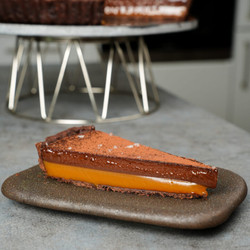Add the flour, cocoa powder, salt, and sugar to a food processor. You can also do this without a food processor if you wanted to, just mix it all in a bowl. If using a food processor, give it a quick blitz to get everything well mixed
Then add in the cold cubes of butter (I place the cubes of butter in the freezer for 30 minutes beforehand to ensure they're completely cold)
Blitz till the butter is well incorporated throughout. Either a sandy texture or small lumps of butter throughout is what we're aiming for. If mixing by hand, use a pastry blender or fork
Next add in the cold milk and pulse/mix briefly until incorporated. You'll know it's done when the dough is cohesive and holding together
Turn the pastry dough out onto the counter. Gather and press the dough together to form a cohesive dough, then flatten into a disc. Try and avoid kneading here as we don't want to develop the gluten
Wrap the disc tightly in baking paper or cling film and refrigerate for at least 3 hours
After the dough has chilled, flour the counter as well as both sides of the dough
Start rolling out the dough from the midpoint down (in one direction), rotate the dough and repeat. Keep rotating and rolling in one direction to avoid cracks forming
The dough should be no thinner than 3mm and should be about 2 inches larger than the tart tin (we're using a 10" tart tin)
Flour the dough and your rolling pin, and roll the dough around the rolling pin. Then carefully unroll the dough over your tart tin. Try and line this up well so that the dough is already roughly in place
Gently press the dough into the crevices and trim off the excess with a sharp knife. Trim off away from the tin to ensure a clean cut.
Brush off any excess flour then dock all over with a fork. Cover with baking paper or clingfilm and refrigerate for 30-60 minutes (this will reduce shrinkage post baking)
Pre-heat your oven to 170'C (fan)/190'C (conventional) - 340'F/375'F
Then place the tart tin onto a larger baking tray, this will help with placing it into the oven and taking it out as tart tins can be fiddly. Scrunch up some baking paper and place on top (the scrunching helps it to get into all the corners), followed by some baking beans/dried beans/dried rice to weight it down (this is called blind baking)
Place the tart shell into the oven to bake for 20 minutes. After this remove the paper and rice, and place the pastry back into the oven to bake for another 15 minutes. The paper and rice/beans should lift off with ease without any sticking - if it sticks then the pastry is underbaked. Place back into the oven for another 5 minutes and then try to remove the paper and rice. Keep the rice/beans in a separate container and reuse for future blind baking needs
Once the tart shell has baked, allow to cool for 15 minutes in the tin before carefully removing and transferring to a wire rack to cool completely. Once cooled, place back into the tin for the next steps
For the caramel, start by melting the sugar in a saucepan over a medium-low heat. Avoid metal utensils here as they can cause the caramel to crystalise. You can however use a silicon spatula to gently move around the sugar to ensure it is all melting evenly
Once the sugar has melted and caramelised, allow it to reach a deep amber colour. And then immediately add in the butter followed by the double cream/heavy cream. It can splatter so just be careful here
Also add in the vanilla bean paste/extract and salt at this stage
Keep whisking and mixing until you're left with a silky, velvety caramel sauce. You may find the caramel seizes and crystalises when adding the cream, keep whisking over a low heat to help it dissolve. You can also place a lid over the saucepan and whisk every 2 minutes until it's fully smooth again. For extra precision (HEAVILY ADVISED), if you have a cooking thermometer take the caramel up to 113'C/235'F
Allow the caramel to cool for just a few minutes, it should still be pourable but just not extortionately hot. Pour over the chocolate pastry shell and allow to come to cool to room temperature, then refrigerate till completely set (about 2-3 hours)
Place the roughly chopped chocolate of choice into a heat resistant bowl and set aside
For the ganache, start by placing the cream on a medium-low to low heat. We just want to see gentle bubbling and steam around the outside. If the cream is too hot, it will cause your ganache to split and turn grainy
Pour the cream over the chocolate
Allow to sit for 1 minute, then slowly start whisking the cream and chocolate together. I find the most effective way is to start whisking in the middle and then slowly start working outwards
Once it looks smooth, switch to a spatula just to make sure everything has been really well incorporated and no chocolate is left stuck to the bowl
Pour the warm ganache over the chilled and set caramel
Immediately tilt the tin around to spread into an even layer - this will start to thicken fairly quickly so work fast here. Then place back into the fridge to set completely
Finish with a dusting of cocoa powder and flaky sea salt right before serving
